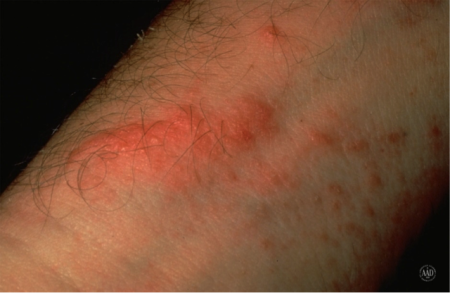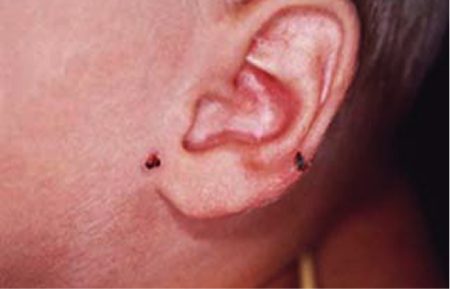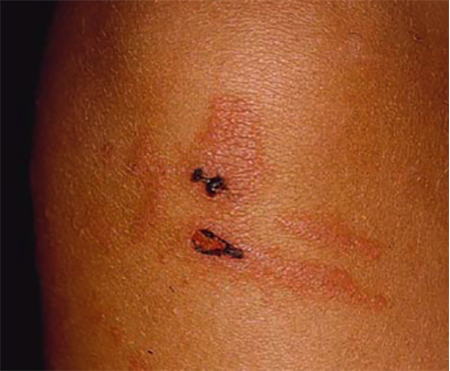Images
Image 1 used with permission of the American Academy of Dermatology National Library of Dermatologic Teaching Slides.
Poison ivy, oak, and sumac: What does the rash look like?
While rare, some people see black spots instead of a red rash on their skin. These spots look like black lacquer spilled onto the skin. Instead of black spots, some people develop black streaks on their skin.
If you develop black spots or streaks, there tends to be little or no redness and swelling. The medical term for this condition is black-spot poison-ivy dermatitis.
Poison ivy rash
A rash from one of these poisonous plants usually shows up as red, itchy bumps on the skin.

Black-spot poison-ivy dermatitis
A few people develop black spots or streaks of black on their skin rather than a red rash.

Poison ivy rash: Streaks and spots
This 7-year-old boy developed red streaks and black spots.

How does the rash show up on the skin?
It takes time for the rash to appear. A rash can develop in a few hours if you’ve had a rash from one of these plants before. If you’ve never had a rash from poison ivy, oak, or sumac, it can take 2 to 3 weeks before you see a rash.
No matter how long it takes for the rash to appear, most people experience the following when they get a rash:
- The skin itches intensely where the rash will appear. The itch can be so intense that it wakes you from a sound sleep.
- Shortly after your skin starts to itch, the rash appears. Most people develop an itchy, red, and blistering rash.
- If you have blisters, they break open and leak fluid.
- The blisters crust over, and the rash clears in 2 to 3 weeks. The rash will clear without treatment, but it can be extremely itchy until it clears completely.
The intensity of the itch and severity of the rash can differ from person to person. Some people develop 1 or 2 small rashes. Others develop rashes all over.
Why does the rash from poison ivy, oak, or sumac spread?
While it may look like the rash is spreading, what’s most likely happening is that you’re developing one or more new rashes. This happens because you either:
- Got urushiol (the oil from these plants that causes the rash) on more than one area of your skin. Typically, the skin with the most oil on it develops a rash first. Skin with less oil tends to react later.
- Touched something that still has urushiol on it, such as the unwashed clothing you were wearing when you brushed up against one of these poisonous plants. Urushiol doesn’t have to be on the plant to cause a rash.
If your new rash appears near the current rash, it can look like the rash is spreading.
Many people also mistakenly believe that when they touch their rash, they can spread the rash from one part of their body to another. You cannot spread the rash.
If you have oil from the plant on your skin, you can spread the oil for a short time. Your skin absorbs the oil quickly, so you can only spread the oil from one part of your skin to another for a short amount of time.
How long does a rash from poison ivy, oak, or sumac last?
How long you have a rash depends on whether you’ve had a rash from one of these plants before. Here’s the general rule:
- Previous rash from poison ivy, oak, or sumac: The rash tends to last 1 to 14 days before it clears on its own.
- Never had a rash from poison ivy, oak, or sumac: You can have a rash for 21 days or longer before it goes away.
If you’re wondering why you develop a rash from these plants, you’ll find the answer at: Poison ivy, oak, and sumac: Who gets a rash, and is it contagious?
Images
Image 1 used with permission of the American Academy of Dermatology National Library of Dermatologic Teaching Slides.
Images 2,3 used with permission of the Journal of the American Academy of Dermatology.
- J Am Acad Dermatol 2001;45:246-9.
References
Kurlan JG, Lucky AW. “Black spot poison ivy: A report of 5 cases and a review of the literature.” J Am Acad Dermatol 2001;45:246-9.
McGovern TW. “Dermatoses due to plants.” In: Bolognia JL, et al. Dermatology. (second edition). Mosby Elsevier, Spain, 2008: 255-6.
- About AAD
- Contact AAD
- Donate
- Employment
- Store
- Support AAD
- Website feedback
- AAD meetings & events
- Advertise
- Classifieds
- Licensing
- Mailing lists
- Meeting advertising
- Legal notice
- Corporate partners
- Donors
- Exhibitors: 2023 Annual Meeting
- Media
- International
- For AAD members
- Patient advocates
- Diseases & conditions
- Everyday care
- Cosmetic treatments
- Public health programs
- Find a dermatologist
Reproduction or republication strictly prohibited
without prior written permission.
What Does Poison Ivy Look Like?
Vincent Iannelli, MD, is a board-certified pediatrician and fellow of the American Academy of Pediatrics. Dr. Iannelli has cared for children for more than 20 years.
Updated on August 17, 2022
Emily is a board-certified science editor who has worked with top digital publishing brands like Voices for Biodiversity, Study.com, GoodTherapy, Vox, and Verywell.
:max_bytes(150000):strip_icc()/GettyImages-157161379-36eb311f9a9a47a0993e803d32e7c2e3.jpg)
Table of Contents
Table of Contents
Poison ivy (Toxicodendron radicans or Toxicodendron rydbergii) and its cousins, poison oak and poison sumac, grow widely throughout North America. While not truly poisonous, they all cause a painful, itchy rash upon contact due to the oil (called urushiol) in their leaves, stems, and roots. Learning to identify poison ivy and the rash it causes can help with both treatment and prevention.
Poison Ivy Rash
:max_bytes(150000):strip_icc()/poison_ivy_rash-56a6fba23df78cf772914532.jpg)
The urushiol in poison ivy, oak, and sumac remains in the roots, stems, and leaves of the plant whether it’s alive, dried up, or dead, so you can get a poison ivy rash even in the winter.
If you think you have touched poison ivy, immediately wash your skin and clothes with soap and cool water or a poison ivy cleanser to:
- Remove as much urushiol as possible
- Lessen the severity of the rash
- Prevent the oil from spreading on your body or around your home
Poison ivy plants should never be burned because the vapors can carry urushiol through the air and cause dangerous inflammation of the airway if they are inhaled.
Symptoms
Symptoms of poison ivy rash develop anywhere from 1 to 7 days after exposure, depending on how much urushiol is present, the skin’s thickness, and how sensitive the person is.
A poison ivy rash has the following features:
- Itching
- Painful blisters or vesicles filled with fluid
- Red bumps that appear in straight lines or streaks
- Swelling
The symptoms of poison ivy rash can worsen over the days following contact. The rash tends to take longer to appear on areas with thicker skin, such as elbows and knees.
Although it may be difficult (especially for children), try not to scratch the affected areas, as this can cause infections to develop. However, it is a myth that scratching and/or open blisters can spread the rash to different areas of the body or to other people.
Remedies
There is no cure for poison ivy rash other than time. Poison ivy rash generally takes about 7-10 days to resolve.
However, there are home remedies that can help relieve the symptoms and encourage healing. While the rash can be painful and irritating, it does not generally require medical treatment. Some home remedies to try:
- Over-the-counter (OTC) cortisone: Topical steroid creams and gels can lessen inflammation and help heal poison ivy rash faster.
- Anti-itch creams: A variety of creams and lotions can help soothe the itchiness of the rash, such as Calamine Lotion, Caladryl Clear Topical Analgesic Skin Lotion, and Aveeno Anti-Itch Cream.
- Cool compresses: Apply cool, wet compresses to the itchy areas for 15 to 30 minutes several times a day.
- Cool oatmeal baths: Cool or lukewarm oatmeal baths can help relieve the itchiness and provide relief while the rash heals.
When to Seek Medical Attention
While poison ivy rash can usually be treated at home, you should seek urgent medical attention if you experience any of these severe symptoms:
- Fever
- Shortness of breath
- Swelling, especially on the face
- Trouble swallowing
You should also seek medical attention if the rash is on your face, genitals, or a large area of your body. Your doctor may prescribe antibiotics or corticosteroids to speed the healing process.
What Does Poison Ivy Look Like?
:max_bytes(150000):strip_icc()/DSC_0364-56a6fb725f9b58b7d0e5d51d.jpg)
Although poison ivy isn’t the only plant with leaves that grow in clusters of three, the adage “leaves of three, leave them be” is a smart way to avoid coming into contact with it. Learning how to identify poison ivy, oak, and sumac by several characteristics will help ensure that you know exactly which plants to avoid.
There are two types of poison ivy in the United States: eastern and western. The western type is a low-growing shrub that is typically under 3 feet tall. Eastern poison ivy is a vine that can grow quite long, either along the ground or as a fuzzy root-covered vine climbing up tree trunks.
- Leaves: Both eastern and western poison ivy have green, 2- to 4-inch-long leaves that grow in groups of three. Young plants may display reddish, droopy leaves. Mature poison ivy leaves are smooth, either glossy or dull, and turn bright red and yellow in the fall. The leaf edges can be lobed or smooth.
- Flowers and berries: In the spring, small yellow flowers bloom close to the vine of the plant. Later in the summer, the blossoms are replaced by light green, gray, or white berries.
- Roots and stems: Poison ivy stems are thornless. They will root where they make contact with the ground, which makes the plant difficult to kill because pieces of the stem and roots can grow into new plants.
The University of Massachusetts Extension Weed Herbarium offers pictures of various parts of the poison ivy plant to help with identification.
Where It’s Located
Poison ivy grows throughout the United States with the exception of Alaska, Hawaii, the rainforests of Washington state, and some arid deserts of the west. It can be found in forests and wetlands, on beaches, along streams, and even in urban parks and yards.
Poison ivy thrives in partial shade, so it’s more common along the edge of forests and trails than in completely shaded areas or sunny spots.
However, it’s smart to keep an eye out even in the deep woods, as this plant is able to grow in a wide range of conditions.
The two types of poison ivy do have slightly different geographic ranges:
- Eastern poison ivy: As its name suggests, eastern poison ivy is native to New England and grows prolifically in the eastern parts of North America, though it can be found as far west as Arizona.
- Western poison ivy: The term “western” is somewhat misleading, as western poison ivy grows all over the U.S. It is found across the western states, the Great Plains, and in the northeast.
Other Forms to Watch for
Poison oak and sumac are in the same genus as poison ivy (Toxicodendron) and contain the same skin irritant, urushiol. While the terms are often used interchangeably, there are differences in appearance between poison ivy, oak, and sumac.
What Does Poison Oak Look Like?
Poison oak has three leaflets like poison ivy, but its leaves have rounded edges (similar to oak leaves). Their undersides are fuzzy and are generally lighter green than poison ivy.
The plant is also more shrub-like without the long vining stems that poison ivy often displays. Poison oak grows mostly west of the Rocky Mountains.
What Does Poison Sumac Look Like?
Poison sumac has more than three leaves. In fact, it can have seven to 13 smooth leaflets arranged in pairs along a slender stem. It looks like a shrub or small tree that can reach a height of 25 feet. In the fall, poison sumac has red stems with orange-red leaves.
This plant is most common in the southeastern United States, although it can also be found in the Great Lakes region and in the northeast.
Tips for Avoiding
Because the slightest contact with poison ivy can cause a rash, protect yourself and your family by taking precautions when you are outdoors:
- Wear the right clothing: When spending time in areas where poison ivy thrives, wear long pants, a long-sleeved shirt, and boots with tall socks.
- Wear gloves: If working in an area where you might come into contact with poison ivy, wear gloves and be sure they are long enough to cover the ends of your shirt sleeves, and do not touch your face or any other exposed areas.
- Choose the correct footwear: Boots are best if you’re hiking because they will protect your ankles and feet. Always wear closed-toe shoes anywhere poison ivy might be growing.
- Avoid areas where poison ivy is common: Stick to the middle of paths and trails, avoiding shortcuts through the woods.
- Know what to look for: Learn the identifying features of all three plants, and teach your kids how to spot them, too.
- Change clothes and clean equipment afterward: Because touching clothing, pets, or other materials that came into contact with the plant can transfer the irritating oils to your skin, wash everything with water and soap (including pets) after any possible exposure.
- Use a poison ivy skin cleanser: If you know you have touched poison ivy, using a product such as Tecnu Extreme (which combines an exfoliant with a cleanser to remove the urushiol) can help reduce your chances of developing a rash.
- Use protective lotion: Bentoquatam lotion (sold as Ivy Block) can prevent poison ivy rashes by protecting your skin from the plant’s oils. Apply it 15 minutes before possible exposure to the plant, and then every 4 hours afterward. Ask your doctor before using on children under the age of 6.
Bentoquatam cannot be used as a treatment for an existing rash; it is only a preventative measure.
A Word From Verywell
Even if you can identify poison ivy, poison oak, and sumac, it’s possible to bump into it accidentally or get a rash through contact with the oils on pets or clothes. If you start developing a rash, be sure to administer home remedies or OTC treatments as soon as possible to relieve your symptoms. You can also call your healthcare provider if you have any concerns.
Verywell Family uses only high-quality sources, including peer-reviewed studies, to support the facts within our articles. Read our editorial process to learn more about how we fact-check and keep our content accurate, reliable, and trustworthy.
- U.S. Forest Service. Welcome to the Forest Service: A guide for volunteers.
- Des Moines University of Medicine and Health Sciences. Everything you need to know about poison ivy.
- American Academy of Dermatology. Poison ivy, oak, and sumac.
- University of Massachusetts Amherst Center for Agriculture, Food, and the Environment. Poison ivy.
- American Academy of Dermatology Association. Poison ivy, oak, and sumac: how to treat the rash.
- Rocky Mountain Research Station; Fire Sciences Laboratory. Toxicodendron radicans, T. rydbergii.
- Army Public Health Center. Poison Sumac Fact Sheet.
- U.S. National Library of Medicine. Bentoquatam topical.
By Vincent Iannelli, MD
Vincent Iannelli, MD, is a board-certified pediatrician and fellow of the American Academy of Pediatrics. Dr. Iannelli has cared for children for more than 20 years.






